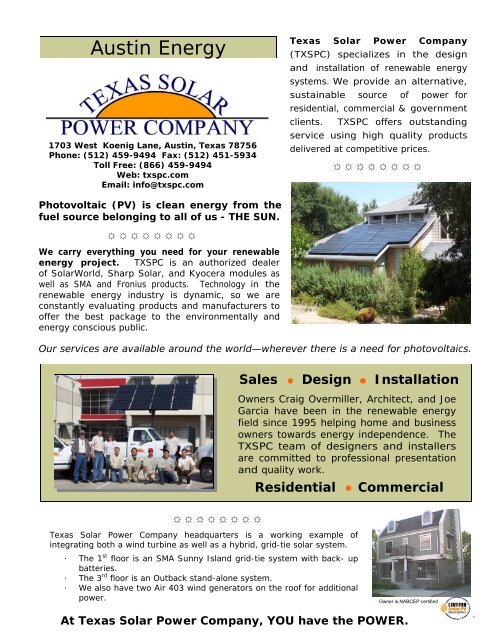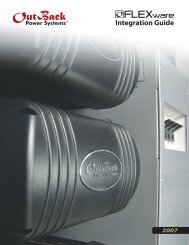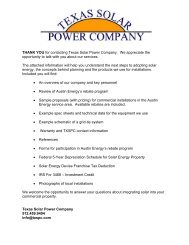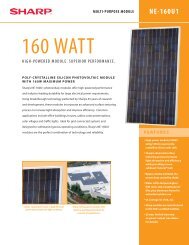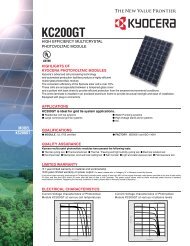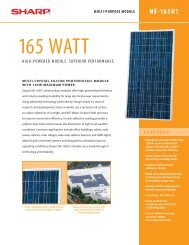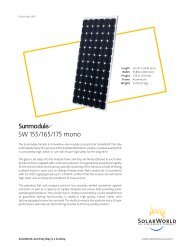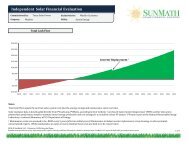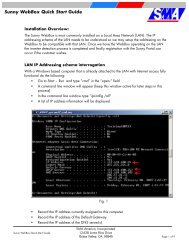Austin Energy - Texas Solar Power Company
Austin Energy - Texas Solar Power Company
Austin Energy - Texas Solar Power Company
You also want an ePaper? Increase the reach of your titles
YUMPU automatically turns print PDFs into web optimized ePapers that Google loves.
<strong>Austin</strong> <strong>Energy</strong><br />
1703 West Koenig Lane, <strong>Austin</strong>, <strong>Texas</strong> 78756<br />
Phone: (512) 459-9494 Fax: (512) 451-5934<br />
Toll Free: (866) 459-9494<br />
Web: txspc.com<br />
Email: info@txspc.com<br />
<strong>Texas</strong> <strong>Solar</strong> <strong>Power</strong> <strong>Company</strong><br />
(TXSPC) specializes in the design<br />
and installation of renewable energy<br />
systems. We provide an alternative,<br />
sustainable source of power for<br />
residential, commercial & government<br />
clients. TXSPC offers outstanding<br />
service using high quality products<br />
delivered at competitive prices.<br />
☼ ☼ ☼ ☼ ☼ ☼ ☼ ☼<br />
Photovoltaic (PV) is clean energy from the<br />
fuel source belonging to all of us - THE SUN.<br />
☼ ☼ ☼ ☼ ☼ ☼ ☼ ☼<br />
We carry everything you need for your renewable<br />
energy project. TXSPC is an authorized dealer<br />
of <strong>Solar</strong>World, Sharp <strong>Solar</strong>, and Kyocera modules as<br />
well as SMA and Fronius products. Technology in the<br />
renewable energy industry is dynamic, so we are<br />
constantly evaluating products and manufacturers to<br />
offer the best package to the environmentally and<br />
energy conscious public.<br />
Our services are available around the world—wherever there is a need for photovoltaics.<br />
Sales Design Installation<br />
Owners Craig Overmiller, Architect, and Joe<br />
Garcia have been in the renewable energy<br />
field since 1995 helping home and business<br />
owners towards energy independence. The<br />
TXSPC team of designers and installers<br />
are committed to professional presentation<br />
and quality work.<br />
Residential<br />
Commercial<br />
☼ ☼ ☼ ☼ ☼ ☼ ☼ ☼<br />
<strong>Texas</strong> <strong>Solar</strong> <strong>Power</strong> <strong>Company</strong> headquarters is a working example of<br />
integrating both a wind turbine as well as a hybrid, grid-tie solar system.<br />
· The 1 st floor is an SMA Sunny Island grid-tie system with back- up<br />
batteries.<br />
· The 3 rd floor is an Outback stand-alone system.<br />
· We also have two Air 403 wind generators on the roof for additional<br />
power.<br />
Owner is NABCEP certified<br />
At <strong>Texas</strong> <strong>Solar</strong> <strong>Power</strong> <strong>Company</strong>, YOU have the POWER.
How much <strong>Solar</strong> <strong>Power</strong> do I need?<br />
Step #1: First things first, CONSERVATION.<br />
Before you begin to “size” a solar system for your existing home, <strong>Texas</strong> <strong>Solar</strong> <strong>Power</strong> <strong>Company</strong><br />
recommends that you implement several energy management and conservation techniques in order<br />
to reduce your overall need for energy:<br />
• Change all incandescent and halogen light sources to compact fluorescent lighting (CFLs).<br />
Home Depot is a great source for these indoor or outdoor lamps and fixtures. Most compact<br />
fluorescent lamps will fit into existing lamp sockets. This will result in double savings – fewer<br />
watts used to light a space AND less A/C used to cool down the air around those little heat<br />
lamps!<br />
• Wherever possible, add additional insulation to your attic walls and floors. Use pipe<br />
insulation on heated water pipes. Insulate your hot water heater.<br />
• Add shading devices and/or solar screens to your east, south, and west-facing windows.<br />
However, during winter months, you may want to take off the south-facing screens in order to<br />
gain solar heat.<br />
• If you have old appliances, consider upgrading. Today’s appliances are much more energy<br />
efficient than those made as few as 5 years ago. We highly recommend that you purchase<br />
only <strong>Energy</strong> Star rated appliances and air conditioning equipment.<br />
• Use natural gas or propane appliances where possible for cooking, central heating, water<br />
heating, and for your clothes dryer. Better yet, dry your clothes via solar (clothesline)!<br />
Step #2: What do you want to do with the power?<br />
If you are already served by a power company, it is considerably cheaper to purchase a “grid-tie”<br />
system. If you want to be totally independent of your energy company and/or you need electricity in a<br />
location that is not yet served by your energy company and it would be very expensive to connect,<br />
you will want to consider a “Battery Stand-Alone” system. A “Battery Back-up” system is a<br />
combination of the two systems, where batteries are used as a back up for a power outage in an<br />
emergency situation.<br />
<br />
<br />
<br />
Grid-tie: You generate power during the day (while the sun is out) so if you’re producing<br />
more than you’re using, your meter will run backwards. Your energy company supplies the<br />
power you use at night, so your meter will run forwards. This push-pull will “net” at the end of<br />
the month with a balance either in the customer’s favor or in the electric company’s favor. In<br />
this dynamic, the power company acts as a huge energy storage device/battery.<br />
Battery Stand-Alone: Along with the solar panels and support system, you will need to<br />
purchase batteries. Your solar panels charge the batteries and you then draw energy<br />
needed for your house from the batteries. You would need to determine all energy needs<br />
and make sure your system is large enough to acquire and store enough energy.<br />
Battery Back-Up: This is a hybrid system that is useful when power goes out. You can predetermine<br />
which appliances should never be without energy, and then store that needed<br />
power. For example, you might have emergency back up for your refrigerator, computer, and<br />
4 lights.<br />
Step #3: Consider how much power you actually use.<br />
Realistically, you will probably look to supplement your power needs via solar (“grid-tie” as described<br />
above) rather than use a Battery Stand-Alone system. If you want more information about battery<br />
back up and true system sizing, please let us know – we have an overview you can use to determine<br />
your full power needs. However, if you simply want an understanding of how much electricity you use<br />
and how much a solar system will produce, follow the steps below.
One way to look at the math:<br />
1. <strong>Solar</strong> systems are generally sized in 1 kW – 6 kW (and larger) systems. A typical size<br />
is 3 kW.<br />
2. 3 kW, or 3 kilowatts = 3,000 watts<br />
3. A 3 kW system will generate around 3,000 watts per hour<br />
4. Multiply the per hour generation by 5.4 which is an average number of sun hours in a<br />
day (3,000 x 5.4 = 16,200)<br />
5. Multiply the new total by the average number of days in a month (16,200 x 30.5 =<br />
487,620)<br />
6. Multiply the new total by .77. This is the “derating” factor, or the amount of energy<br />
lost when DC current is turned into AC current. (487,620 x .77 = 375,467)<br />
7. So, a 3 kW system will generate about 375,467 watt-hours per month, or about 375<br />
kWh.<br />
8. Now compare this number with the kWh usage noted in your electric bill. How many<br />
kWh do you use in a typical month? Twice this amount? Then you would save<br />
roughly ½ your electric bill if you installed a 3 kW system.<br />
9. Consider how much money you save per month to figure out how long it will take to<br />
pay off your system.<br />
Another way to look at the math – in reverse:<br />
1. Take a look at your electric bill to find the number of kilowatt-hours (kWh) you use in<br />
a month. Remember that your summer bills may be higher than those in winter (or<br />
vice versa) so determine an average.<br />
2. Multiply your kWh by 1000 to get a number in terms of watts.<br />
3. Divide this number by the average number of days in a month: 30.5<br />
4. Divide the resulting number by the average number of good hours of sunlight per<br />
day: 5.4<br />
5. Now divide the resulting number by the output of the solar module you intend to use.<br />
A standard is 175 watts.<br />
6. The resulting number is about how many modules you would need to meet all your<br />
power needs.<br />
Step #4: Information to keep in mind when considering a solar system.<br />
A. Up to 30% of the final cost of installation (minus any rebates) can be taken as a<br />
federal tax credit. Previous versions of this credit had a cap of $2,000; there is no<br />
longer a cap.<br />
B. The most productive system is located on a South- or West-facing roof (or area) that<br />
is shade-free from 9 am – 3 pm every day of the year.<br />
C. Generally speaking, you will need ~ 1 square foot of space for every 10 watts. So a<br />
3 kW system would take ~ 300 square feet; a 4 kW system would take ~ 400 square<br />
feet.<br />
D. You do not need to size a system to meet all your energy needs. You will remain a<br />
customer of your electric company, so you can use more (or less) power as needed.<br />
E. When considering “payback” time, think about the price of electricity per kWh. Has it<br />
increased in the past? Will it increase in the future? By how much? We do not know<br />
the answer either, but the question should be factored in to your decision-making.<br />
F. All energy providers are obligated to allow “net-metering” which means that the<br />
electric meter must be able to run backwards (i.e. when you are generating<br />
electricity). However, they are not obligated to pay you a set $ amount, or anything<br />
at all, if you generate more energy than you use in a month. Check with your energy<br />
provider to find out their particular “Tariff Agreement”.<br />
G. Be sure to check with your Homeowners’ Association before committing to a solar PV<br />
installation. For some odd reason that we simply cannot imagine, some are opposed<br />
to the “look” of solar.
SAMPLE PROPOSAL<br />
Date: March, 2009<br />
Sales Person: VG<br />
1703 W. Koenig Ln. <strong>Austin</strong>, TX 78756<br />
Phone: 512-459-9494 Fax: 512-451-5934<br />
Website: txspc.com<br />
Email: info@txspc.com<br />
To: <strong>Austin</strong> <strong>Energy</strong> Customer Project: Grid tie PV System<br />
3150 DC Watts<br />
Turn-key Installation<br />
Item No.<br />
Description<br />
Amount<br />
1 3150 Watts DC <strong>Solar</strong> System<br />
$<br />
14,500.00<br />
2<br />
3<br />
4<br />
5<br />
6<br />
7<br />
Components of this turn-key system include:<br />
<strong>Solar</strong> Modules<br />
Inverter<br />
Array Frames<br />
DC/ AC Disconnect<br />
Two pole Breaker<br />
8 Combiner Box<br />
9 Wire, Conduit and Connecters<br />
10 Permits and integration with local energy provider<br />
11<br />
12<br />
13<br />
14<br />
15<br />
16<br />
Pricing may vary due to product supply and market fluctuation. Subtotal $<br />
14,500.00<br />
Sales Tax 0.0825 $<br />
1,196.25<br />
Labor $<br />
6,450.00<br />
Total $<br />
22,146.25<br />
<strong>Austin</strong> <strong>Energy</strong> Rebate $<br />
(13,500.00)<br />
Customer Out-of-Pocket $ 8,646.25<br />
30% Federal Income Tax Credit $<br />
2,593.88<br />
(potential) Final Total $ 6,052.38<br />
Dollar per Watt Before Incentives $<br />
7.03<br />
I agree to the terms of this proposal. I authorize <strong>Texas</strong> <strong>Solar</strong> <strong>Power</strong> <strong>Company</strong><br />
to schedule the next available TXSPC professional to begin work on my project.<br />
X _______________________________________________________<br />
If you have any questions concerning this proposal, call Craig Overmiller, Sec./Treas. @ 512-459-9494.
1703 W. Koenig Lane <strong>Austin</strong>, TX 78756<br />
Phone:(512) 459-9494 Fax:(512) 451-5934 Info@txspc.com<br />
<strong>Solar</strong> Rebates<br />
<strong>Austin</strong> <strong>Energy</strong> has one of the best rebate programs in the country to encourage solar installations in<br />
<strong>Austin</strong>. Please take a look at their website for full information: www.austinenergy.com. Check under<br />
“rebates.” Below is a summary of program steps. If you are working with <strong>Texas</strong> <strong>Solar</strong> <strong>Power</strong><br />
<strong>Company</strong> (TXSPC), we will handle the paperwork for you.<br />
1. Submit a Site Survey Request to <strong>Austin</strong> <strong>Energy</strong> via austinenergy.com website.<br />
2. Have a site pre-inspection by an <strong>Austin</strong> <strong>Energy</strong> Representative. At this inspection the<br />
representative will determine if your site qualifies for the rebate and the amount of wattage<br />
your site will support. A service upgrade may be required, which is an additional cost.<br />
3. Contact an installer on the approved installer list at <strong>Austin</strong> <strong>Energy</strong> website for a bid.<br />
4. Give a signed Rebate Application and a Renewable <strong>Energy</strong> Assignment Agreement to the<br />
installer, who will then send them to <strong>Austin</strong> <strong>Energy</strong> with a PV Watt Calculator Form.<br />
5. <strong>Austin</strong> <strong>Energy</strong> will then send you a Letter of Intent (LOI), which will state system size and<br />
rebate amount. You must have an LOI before you can start your PV installation.<br />
6. When your LOI arrives contact your PV Installer to schedule an installation.<br />
7. Upon completion of the installation <strong>Austin</strong> <strong>Energy</strong> will perform a post inspection of your system<br />
to insure it meets program guideline requirements. The homeowner needs to be at this<br />
inspection. (NOTE: Modules and/or inverters installed may be different than proposed. This<br />
is due to availability of equipment. All equipment used shall meet <strong>Austin</strong> <strong>Energy</strong><br />
Requirements.)<br />
8. At the post inspection, you will be asked to assign the rebate to yourself or to your PV Installer.<br />
If you have the rebate go to yourself there are tax implications. You may be taxed for<br />
unearned income. We suggest that you check with your tax advisor.<br />
9. Your out-of-pocket expense is the installation amount minus your rebate.<br />
a. <strong>Austin</strong> <strong>Energy</strong> rebates the total DC watts X $4.50 X inverter efficiency (average 94%).<br />
b. The typical rebate for a 3 kW system will be approximately $13,395.95.<br />
c. The maximum rebate is $13,500.00 for residential, $100,000.00 for commercial or 80%<br />
of the total system cost, whichever is less.<br />
10. It can take up to 5 weeks for your PV meter to be installed and your PV system turned on.<br />
11. Your new meter will show Delivered <strong>Energy</strong> (DE), Received <strong>Energy</strong> (RE), and Net <strong>Energy</strong><br />
(NE). Your PV system will have a separate meter so you can monitor system performance.<br />
There are two moving dashes on your Revenue Meter. If they are going to the right, you are<br />
buying power; if they are moving left, you are selling power at the wholesale rate. If within any<br />
month your PV system produces more energy than is needed on-site, <strong>Austin</strong> <strong>Energy</strong> will credit<br />
your bill based on the current fuel charge rate. GreenChoice ® subscribers will be credited at<br />
the GreenChoice ® rate.<br />
If you have any questions about the program please contact <strong>Austin</strong> <strong>Energy</strong> or TXSPC at the above<br />
number.<br />
Sincerely,<br />
Craig M. Overmiller<br />
Secretary / Treasurer
This is an example of the components<br />
used to tie into your standard power<br />
grid. These will be added (l to r):<br />
1. Inverter<br />
2. DC Disconnect<br />
3. AC Disconnect<br />
4. PV Meter<br />
These are pre-existing on your home:<br />
5. Revenue Meter<br />
6. Breaker Box, or Load Center<br />
This is an example of a<br />
3kw system consisting of<br />
18 panels @ 175 watt<br />
each.
1703 W. Koenig Lane <strong>Austin</strong>, TX 78756<br />
Phone:(512) 459-9494 Fax:(512) 451-5934 Email:Info@txspc.com<br />
WARRANTIES<br />
<strong>Solar</strong> Panels<br />
25 Year Prorated Warranty<br />
Charge Controller<br />
2 Year Limited Warranty<br />
Inverter<br />
10 Year Limited Warranty<br />
Batteries<br />
As per Manufacturer<br />
<strong>Solar</strong> Hot Water<br />
5 Year Limited Warranty<br />
Installation<br />
5 Year Unlimited Labor and Material<br />
If for any reason any equipment fails during this five year period <strong>Texas</strong> <strong>Solar</strong> <strong>Power</strong><br />
<strong>Company</strong> will replace or repair at no cost to the customer. This warranty is transferable in<br />
the event of sale of home or office.<br />
<strong>Texas</strong> <strong>Solar</strong> <strong>Power</strong> <strong>Company</strong> will extend all manufacturer warranties for a period of ten<br />
years from the date of system installation (excluding batteries and charge controllers).<br />
EMERGENCY PHONE NUMBERS<br />
Office Address: 1703 West Koenig Lane<br />
<strong>Austin</strong>, <strong>Texas</strong> 78756<br />
Office Hours:<br />
Monday through Friday 9:00 a.m. to 6:00 p.m.<br />
Office Phone: 512-459-9494<br />
Fax: 512-451-5934<br />
Toll Free: 866-459-9494<br />
Craig Overmiller<br />
Cell Phone: 512-632-3237<br />
Email: craig@txspc.com<br />
Joe Garcia<br />
Cell Phone: 512-789-3477<br />
Email: joe@txspc.com
1703 W. Koenig Lane <strong>Austin</strong>, TX 78756<br />
Phone:(512) 459-9494 Fax:(512) 451-5934 Email:Info@txspc.com<br />
References<br />
Commercial Clients:<br />
Iron Knot Retreat Center<br />
Michael Bradfute<br />
Phone: 505-301-3388<br />
21,100 Watts PV<br />
4 Outback 3648 Inverters<br />
64 Deka <strong>Solar</strong> 8A8D Batteries<br />
Community Clinical Research<br />
Sam Dawson<br />
Phone: 512-868-1229<br />
20,000 Watts PV<br />
4 Fronius 5100 IG Inverters<br />
2 Outback 3648 Inverters<br />
16 Trojan 8A8D Batteries<br />
Alori Properties<br />
Jason Aldridge<br />
409 West 38 th Street<br />
Phone: 512-452-3690<br />
25,000 Watts<br />
5 Fronius 5100 IG Inverters<br />
Ebby Construction<br />
George Ebby<br />
<strong>Austin</strong>, <strong>Texas</strong><br />
Phone: 263-0805<br />
16,000-Watts <strong>Solar</strong><br />
6 Trace 5548 Inverters<br />
24 MK 8A31 AGM Batteries Batteries<br />
<strong>Texas</strong> A&M University<br />
Forrest McCartney<br />
Phone: 979-845-5318<br />
4000 Watts PV<br />
1-Xantrex GT 3.0 Inverter<br />
1-Xantrex 2024 Inverter<br />
1-Southwest Wind Air 403 Wind Generator<br />
1-Southwestwind H80 Wind Generator
Read Trust<br />
Patsy Read<br />
Phone: 477-9996<br />
3000 Watts PV<br />
1-Xantrex 4048 Inverter<br />
2-Southwestwind Air 403 Wind Generator<br />
8-Deka <strong>Solar</strong> 8G27 Gel Cell Batteries<br />
Sportsman’s Finest<br />
Charles Dorrance<br />
12434 FM 2244<br />
Bee Caves, TX<br />
Phone: 263-1888<br />
14KW Grid-tie System<br />
(2) SMA 6000 Watt Inverters<br />
City Of <strong>Austin</strong> Projects<br />
Wild Basin Preserve<br />
David Burgos<br />
Phone: 482-5368<br />
8,000 Watts PV<br />
2-Omnion 5 KW Inverters<br />
Metz Recreation Center<br />
David Burgos<br />
Phone: 482-5368<br />
3000 Watts PV<br />
1-3000 Watt SMA Inverter<br />
Seawright Park<br />
David Burgos<br />
Phone: 482-5368<br />
900 Watts PV<br />
1-Xantrex 1500 Watt Inverter<br />
8-Deka <strong>Solar</strong> 8A31 AGM Batteris<br />
<strong>Austin</strong> Independent School District<br />
David Burgos<br />
Phone: 482-5368<br />
15,600 Watts<br />
5 Fronius IG 44500 Inverters
Edition: March 2007<br />
Length<br />
Width<br />
Height<br />
Frame<br />
Weight<br />
63.39 in (1610 mm)<br />
31.89 in (810 mm)<br />
1.34 in (34 mm)<br />
Aluminium<br />
33 lbs (15 kg)<br />
SW 155/165/175 mono<br />
The Sunmodule Plus heralds an innovative new module concept from <strong>Solar</strong>World AG.<br />
The fully automated production process at the <strong>Solar</strong>World factories creates a quality of<br />
module that is consistently high, which in turn will ensure high yields for the long term.<br />
The module frame and the glass it surrounds are firmly attached to each other by<br />
silicone that is applied with continuous precision. This guarantees exceptional rigidity<br />
for the entire module and stops any possible loosening of the frame as a result of strong<br />
outward forces in cases such as sliding of heavy snow. Tests carried out in accordance<br />
with IEC 61215, applying loads up to 5.4 kN/m 2 , confirm that the module can withstand<br />
heavy accumulations of snow and ice.<br />
The patented, flat and compact junction box provides perfect protection against<br />
corrosion, as well as a capacity to rapidly rid itself of any excess heat providing high<br />
temperature handling. The junction box is reliably connected by a solid, welded bond<br />
to guarantee lasting functionality. In addition, high-quality, robust cables with<br />
factoryequipped connectors are used. The ability to recycle the modules and a 25-year<br />
performance warranty are the finishing touches to this top-quality concept.<br />
<strong>Solar</strong>World. And EveryDay is a SunDay.<br />
www.solarworld.de
SW 155/165/175 mono<br />
Performance under standard test conditions<br />
SW 155 SW 165 SW 175<br />
Maximum power P max 155 Wp 165 Wp 175 Wp<br />
Open circuit voltage V oc 43.6 V 44.0 V 44.4 V<br />
Maximum power point voltage V mpp 34.8 V 35.3 V 35.8 V<br />
Short circuit current I sc 4.90 A 5.10 A 5.30 A<br />
Maximum power point current I mpp 4.46 A 4.68 A 4.89 A<br />
Performance at 800 W/m 2 ,NOCT,AM 1.5<br />
SW 155 SW 165 SW 175<br />
Maximum power P max 110.8 Wp 118.0 Wp 125.1 Wp<br />
Open circuit voltage V oc 39.4 V 39.8 V 40.2 V<br />
Maximum power point voltage V mpp 31.2 V 31.6 V 32.1 V<br />
Short circuit current I sc 4.05 A 4.22 A 4.38 A<br />
Maximum power point current I mpp 3.55 A 3.73 A 3.90 A<br />
Minor reduction in efficiency under partial load conditions at 25°C: at 200 W/m 2 , 95% (+/- 3%) of the STC efficiency (1000 W/m 2 ) is achieved.<br />
Component materials<br />
Cells per module 72<br />
Cell type<br />
monocrystalline silicon<br />
Cell dimensions 125 x 125 mm 2<br />
System integration parameters<br />
Maximum system voltage SC II<br />
Maximum system voltage USA NEC<br />
Maximum series fuse rating<br />
1,000 V DC<br />
600 V DC<br />
15 A<br />
Thermal characteristics<br />
NOCT 46°C<br />
TC I sc<br />
0.036 %/K<br />
TC V oc<br />
-0.33 %/K<br />
Additional data<br />
<strong>Power</strong> tolerance +/- 3 %<br />
Junction box IP 65<br />
Connector MC type 4<br />
Front<br />
Side<br />
Rear<br />
Construction<br />
31.89 (810)<br />
1.34 (34)<br />
30.28 (769)<br />
63.39 (1610)<br />
10.04 (255) 21.65 (550) 21.65 (550) 10.04 (255)<br />
37.4 (950)<br />
Ø 0.35 (9)<br />
Ø 0.16 (4)<br />
Ø 0.35 (9)<br />
* inches (mm)<br />
1<br />
1 ] Front: tempered glass<br />
2] crystalline solar cells embedded<br />
in EVA (ethylene-vinyl-acetate)<br />
3] Rear: Tedlar<br />
2<br />
3<br />
Modules certified in accordance with:<br />
IEC 61215<br />
Safety class II<br />
UL 1703 3rd Ed.<br />
<strong>Solar</strong>World AG reserves the right to make specification changes without notice.<br />
This data sheet complies with the requirements of EN 50380.
SB 3000US / SB 4000US<br />
> Certified to the new<br />
UL1741/IEEE 1547<br />
> Improved CEC efficiency<br />
> Integrated load-break<br />
rated DC disconnect<br />
switch<br />
> Integrated fused series<br />
string combiner<br />
> Sealed electronics<br />
enclosure & Opticool<br />
> Comprehensive SMA<br />
communications and<br />
data collection options<br />
> 5 year standard<br />
warranty with optional<br />
10 year plan<br />
> Ideal for residential or<br />
light commercial<br />
applications<br />
> Rugged cast aluminum<br />
outdoor rated enclosure<br />
Sunny Boy 3000 / 4000<br />
The best in their class<br />
SMA is proud to introduce our new line of inverters updated with our latest technology and designed<br />
specifically to meet the new IEEE 1547 requirements. Compact design makes them ideal for residential<br />
use and the integrated DC disconnect makes installation more cost effective. They are field-configurable<br />
for positive ground systems making them more versatile than ever. Increased efficiency means<br />
better performance and shorter payback periods. With over 500,000 fielded units, Sunny Boy has<br />
become the benchmark for PV inverter performance and reliability throughout the world.
Technical Data<br />
Sunny Boy 3000 / 4000<br />
Input Data (DC)<br />
Recommended Array Input <strong>Power</strong> (DC @ STC)<br />
Max. DC Voltage<br />
Peak <strong>Power</strong> Tracking Voltage<br />
DC Max. Input Current<br />
DC Voltage Ripple<br />
Number of Fused String Inputs<br />
PV Start Voltage (adjustable)<br />
Output Data (AC)<br />
AC Nominal <strong>Power</strong><br />
AC Maximum Output <strong>Power</strong><br />
AC Maximum Output Current<br />
AC Nominal Voltage / Range<br />
AC Frequency / Range<br />
<strong>Power</strong> Factor<br />
Efficiency<br />
Peak Inverter Efficiency<br />
CEC weighted Efficieny<br />
Mechanical Data<br />
Dimensions W x H x D in inches<br />
Weight / Shipping Weight<br />
Ambient temperature range<br />
<strong>Power</strong> Consumption: standby / nighttime<br />
Topology<br />
Cooling Concept<br />
Mounting Location Indoor / Outdoor (NEMA 3R)<br />
Features<br />
LCD Display<br />
Lid Color: aluminium / red / blue / yellow<br />
Communication: RS485 / Wireless<br />
Warranty: 5-year / 10-year<br />
Compliance: IEEE-929, IEEE-1547, UL 1741, UL 1998, FCC Part 15 A & B<br />
Specifications for nominal conditions<br />
Efficiency Curves<br />
SB 3000US<br />
• Included m Option — Not available<br />
SB 4000US<br />
3600 W<br />
4800 W<br />
500 V<br />
600 V<br />
180 – 400 V @ 208 VAC<br />
220 – 480 V @ 208 VAC<br />
200 – 400 V @ 240 VAC<br />
250 – 480 V @ 240 VAC<br />
17 A<br />
18 A<br />
< 5%<br />
< 5%<br />
4<br />
4<br />
228 V<br />
285 V<br />
3000 W<br />
3500 W @ 208 V / 4000 W @ 240 V<br />
3000 W<br />
4000 W<br />
15 A<br />
17 A<br />
183 – 229 V @ 208 VAC<br />
183 – 229 V @ 208 VAC<br />
211 – 264 V @ 240 VAC<br />
211 – 264 V @ 240 VAC<br />
60 Hz / 59.3 Hz – 60.5 Hz<br />
60 Hz / 59.3 Hz – 60.5 Hz<br />
1<br />
1<br />
96.6 %<br />
96.8 %<br />
95.0 % (@ 208 V)<br />
95.5 % (@ 208 V)<br />
95.5 % (@ 240 V)<br />
96.0 % (@ 240 V)<br />
17.8 x 13.8 x 9.3<br />
17.8 x 13.8 x 9.3<br />
88 lbs / 94 lbs<br />
88 lbs / 94 lbs<br />
–13 to +113 °F<br />
–13 to +113 °F<br />
< 7 W / 0.1 W<br />
< 7 W / 0.1 W<br />
PWM, true sinewave,<br />
PWM, true sinewave,<br />
current source<br />
current source<br />
Convection, regulated fan cooling Convection, regulated fan cooling<br />
•/•<br />
•/•<br />
•<br />
•<br />
•/m/m/m<br />
•/m/m/m<br />
m/m<br />
m/m<br />
•/m<br />
•/m<br />
• •<br />
SB3000US-4000US-11:BU1107 Sunny Boy and SMA are registered trademarks of SMA Technologie AG. Text and figures comply with the state of the art applicable when printing. Subject to technical changes. We accept no liability for typographical and other errors. Printed on chlorine-free paper.<br />
www.sma-america.com<br />
Phone 530-273-4895<br />
Toll Free 888-4SMAUSA<br />
SMA America, Inc.
Purchaser<br />
Name<br />
Mailing Address (if different)<br />
Electric Account #<br />
SOLAR PV PROGRAM<br />
REBATE APPLICATION<br />
Installation Address<br />
Email Address<br />
Ref File.<br />
#<br />
Day Phone # Wk. Phone #<br />
Name<br />
Contractor/Installer<br />
Contact Person<br />
Email Address<br />
Installer’s Address<br />
Ph. Number<br />
City, State & Zip Code<br />
Fax Number<br />
System/Installation<br />
Residential<br />
Commercial<br />
Multi-Family<br />
Structure:<br />
New<br />
Existing<br />
Contractor Price Quote:<br />
$<br />
Locally Made:<br />
Yes No<br />
Est. kWh Savings/yr.:<br />
Methodology Used:<br />
PV Module Mfg.*<br />
Model #<br />
STC Rating (watts)<br />
Qty.<br />
Array Orientation<br />
Inverter Mfg.*<br />
Model #<br />
<strong>Power</strong> Rating Efficiency %<br />
*Please list additional modules/inverters on reverse side of this application.<br />
Number of Modules x STC Rating (watts) x Inverter Eff. % = System Rating (W) x Rebate Level = Rebate Amount<br />
Array 1:<br />
x x = x $ = $<br />
Array 2:<br />
x x = x $ = $<br />
AE Inspector _________________________ Application Review Date _____________________ Approved ____ Disapproved ____<br />
I certify that the above listed solar PV equipment meets the program guidelines and requirements of the <strong>Solar</strong> PV Rebate Program and that all<br />
documentation submitted is true and correct to the best of my knowledge. I further certify that the photovoltaic system will be installed in compliance with<br />
<strong>Austin</strong> <strong>Energy</strong>'s technical requirements for distributed generation interconnection (for facilities under 20 kW).<br />
_____________________________________________________________________________________________________________________________________<br />
Vendor/Contractor’s Signature<br />
Date<br />
REFUND AGREEMENT<br />
As a qualified <strong>Austin</strong> <strong>Energy</strong> customer and purchaser of the solar system, I understand the rebate for which I am applying will, under no circumstances,<br />
exceed the maximum allowed under current <strong>Solar</strong> PV Rebate Program guidelines. In order to receive the rebate, I understand that the solar system must be<br />
inspected and approved by <strong>Austin</strong> <strong>Energy</strong>, and I must sign this Refund Agreement that includes, at a minimum, the following conditions. A prorated<br />
portion of the rebate, calculated by reducing the rebate paid by 20% per year for each of the five years following final inspection and approval (first 20%<br />
reduction to occur on the first anniversary date of rebate payment), shall become due and payable to <strong>Austin</strong> <strong>Energy</strong> if I fail to ensure <strong>Austin</strong> <strong>Energy</strong> that the<br />
rebate equipment is properly maintained and operated at an <strong>Austin</strong> <strong>Energy</strong> metered address.<br />
____________________________________________________________________________________________________________________________________<br />
Purchaser’s Signature<br />
Date<br />
Please submit by fax to: (512) 482-5409 or mail to:<br />
<strong>Solar</strong> PV Rebate Program<br />
721 Barton Springs Road<br />
<strong>Austin</strong>, <strong>Texas</strong> 78704<br />
<strong>Solar</strong> Rebate Application Revised April 2007
<strong>Solar</strong> PV Rebate Program<br />
Renewable <strong>Energy</strong> Credit<br />
Assignment Agreement<br />
Ref.#_________<br />
The City of <strong>Austin</strong>, d/b/a <strong>Austin</strong> <strong>Energy</strong> (“<strong>Austin</strong> <strong>Energy</strong>”), committed by City Council to<br />
support renewable energy, is a voluntary participant in the State’s goal to have a total,<br />
cumulative installed generating capacity in <strong>Texas</strong> from renewable energy resources of at least<br />
5,000 megawatts by 2015.<br />
Under the State’s renewable energy goals program, a Renewable <strong>Energy</strong> Credit (REC) represents<br />
the environmental attributes of one thousand kilowatt hours (kWh) of electricity produced by a<br />
renewable resource (such as solar or wind). A REC is a commodity awarded to the generator of<br />
each one thousand kWh of renewable energy produced in the state. RECs are used by electric<br />
providers in <strong>Texas</strong> to account for their participation in the State’s renewal energy goals program.<br />
RECs will be generated by your solar energy system. For example, a three (3) kW residential<br />
solar system generally produces about 4,500 kWh of renewable energy annually (for an optimal<br />
installation), creating approximately 4.5 RECs. RECs have a monetary value on the open<br />
market, which fluctuates with the market. RECs can be sold on the open market and transferred.<br />
You are being asked to assign the RECs—and any other premiums approved by the <strong>Texas</strong> Public<br />
Utility Commission—generated by your solar system to <strong>Austin</strong> <strong>Energy</strong> in order to receive the<br />
solar rebate incentive. The RECs will be aggregated with those of other participants in the <strong>Solar</strong><br />
Rebate Program, and will be used for solar energy programs, to promote the use of solar energy,<br />
and to promote <strong>Austin</strong> <strong>Energy</strong>’s renewable energy goals.<br />
By signing the REC Assignment Agreement, you are agreeing to assign the RECs generated by<br />
your solar system to <strong>Austin</strong> <strong>Energy</strong> in consideration for receipt of a rebate.<br />
I ____________________________(please print) acknowledge that I have read the above<br />
explanation and understand by signing this agreement that I agree to assign the RECs generated<br />
by my solar system at a meter within <strong>Austin</strong> <strong>Energy</strong>’s certificated area to <strong>Austin</strong> <strong>Energy</strong> in<br />
consideration for any solar rebate incentive provided to me.<br />
______________________________________ ______________________________________<br />
Customer Signature<br />
<strong>Company</strong> Name (if applicable)<br />
______________________________________<br />
Installation Address<br />
______________________________________<br />
Date<br />
April 2008
1703 West Koenig Lane, <strong>Austin</strong>, TX 78756<br />
Ph: 512.459.9494 Fax: 512.451.5934 Email: Info@txspc.com<br />
Residential <strong>Solar</strong> Tax Credit – Overview*<br />
Incentive Type: Personal Tax Credit<br />
Eligible Technologies include: <strong>Solar</strong> Water Heat, <strong>Solar</strong> Photovoltaics (i.e. electricity<br />
production)<br />
Applicable Sectors: Residential<br />
Amount: 30%<br />
Maximum Incentive: No maximum for solar-electric systems or solar waterheating<br />
systems<br />
Carryover Provisions: Excess credit may be carried forward to succeeding tax<br />
year.<br />
Eligible System Size: Not specified<br />
Equipment/Installation<br />
Requirements:<br />
<strong>Solar</strong> water heating property must be certified by<br />
SRCC or by comparable entity endorsed by the state in<br />
which the system is installed. At least half the energy<br />
used to heat the dwelling's water must be from solar in<br />
order for the solar water-heating property expenditures<br />
to be eligible.<br />
Authority 1: 26 USC § 25D<br />
Date Enacted: 8/8/2005<br />
Effective Date: 1/1/2006<br />
Expiration Date: 12/31/2008<br />
NOTE: Key points of the <strong>Energy</strong> Policy Act (passed October, 2008) and stimulus package<br />
(passed February, 2009):<br />
• Eight-year extension of the credit to December 31, 2016<br />
• Credit can be used against the alternative minimum tax<br />
• If the federal tax credit exceeds tax liability, the excess amount may be carried<br />
forward to the succeeding taxable year.<br />
• 30% of qualified expenditures for a system. There is no cap.<br />
o System must serve a dwelling unit, located in the US, used as a residence.<br />
o Expenditures include labor costs for onsite preparation, assembly, or<br />
original system installation and for piping or wiring to interconnect a system<br />
to the home.<br />
o The stimulus package appears to allow the tax credit to be taken before any<br />
rebates are factored in. This dramatically affects the bottom line in areas<br />
where rebates are affected.<br />
o If the taxpayer cannot use the tax credit, it appears that it can be taken as a<br />
cash rebate.<br />
The maximum allowable credit, equipment requirements, and other details vary by<br />
technology as outlined below.
<strong>Solar</strong> electric property<br />
• Maximum credit of $2,000 for systems placed in service from January 1, 2006<br />
through December 31, 2008.<br />
• No maximum credit limit for systems placed in service from January 1, 2009<br />
through December 31, 2016.<br />
• The home served by the system does not have to be the taxpayer’s principal<br />
residence.<br />
<strong>Solar</strong> water heating property<br />
• Maximum credit of $2,000 for systems placed in service from January 1, 2006<br />
through December 31, 2008.<br />
• No maximum credit limit for systems placed in service from January 1, 2009<br />
through December 31, 2016.<br />
• Systems must be placed in service from January 1, 2006 through December 31,<br />
2016.<br />
• Equipment must be certified for performance by the <strong>Solar</strong> Rating Certification<br />
Corporation (SRCC) or a comparable entity endorsed by the government of the<br />
state in which the property is installed.<br />
• At least half the energy used to heat the dwelling's water must be from solar in<br />
order for the solar water-heating property expenditures to be eligible.<br />
• The tax credit does not apply to solar water heating property for swimming pools or<br />
hot tubs.<br />
• The home served by the system does not have to be the taxpayer’s principal<br />
residence.<br />
Background<br />
The <strong>Energy</strong> Policy Act of 2005 (Section 1335) established a 30% tax credit up to $2,000<br />
for the purchase and installation of residential solar electric and solar water heating<br />
property and a 30% tax credit up to $500 per 0.5 kilowatt for fuels cells. Initially scheduled<br />
to expire at the end of 2007, the tax credits were extended through December 31, 2008<br />
by Section 206 of the Tax Relief and Health Care Act of 2006.<br />
In October 2008, through the <strong>Energy</strong> Improvement and Extension Act of 2008 (Division B,<br />
Section 106), the tax credits were extended once again – until December 31, 2016 – and<br />
a new tax credit for small wind energy systems and geothermal heat pump systems was<br />
created. In February of 2009 the maximum tax credit was lifted for solar hot water and<br />
the structure of the tax credit was revised.<br />
For more information about the renewable energy component of this tax credit<br />
(including the types and use of eligible property, the credit's interaction with other<br />
incentives, and project ownership requirements), see the <strong>Energy</strong>Star’s website:<br />
http://www.energystar.gov/index.cfm?c=products.pr_tax_credits<br />
Or check the Database of State Incentives for Renewable <strong>Energy</strong> (DSIRE) website:<br />
http://www.dsireusa.org/library/includes/incentive2.cfm?Incentive_Code=US37F&State=fe<br />
deral¤tpageid=1&ee=1&re=1<br />
* This is an edited version by <strong>Texas</strong> <strong>Solar</strong> <strong>Power</strong> <strong>Company</strong>. Please check the link above<br />
and with your personal tax accountant to see how these credits might affect you.


